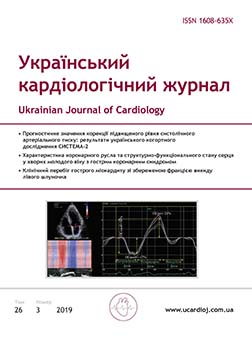Quercetine influence on the resological properties of blood for elderly patients with metabolic syndrome
Main Article Content
Abstract
The aim – to study the effects of quercetin on the functional status of platelets and blood viscosity in elderly patients with metabolic syndrome (MS).
Materials and methods. Fifty patients with MS at the age of 60–75 years, who were equally distributed into the experimental and control groups, were examined. Patients of the experimental group received quercetin for 3 months («Quertin», PJSC SIC «Borshchahivskiy CPP», Ukraine) 80 mg 3 times a day. The control group received placebo for the same period of time. Before and after the treatment, MS criteria, platelet aggregation ability, blood viscosity and serum lipid levels were assessed.
Results and discussion. After quercetin course, the rheological blood properties improved, that is its viscosity, spontaneous and induced platelet aggregation decreased. A statistically significant decrease in serum total cholesterol and LDL cholesterol levels was noted. Correlation analysis showed that an improvement in blood viscosity occurred due to favourable changes in the lipid spectrum and a decrease in the aggregation ability of blood cells.
Conclusions. The obtained results indicate that in elderly patients with metabolic syndrome a course (within 3 months) use of quercetin reduces manifestations of dyslipidemia, increases spontaneous and induced platelet aggregation, contributes to an increase in the erythrocyte deformability index, which together lead to the decrease of blood viscosity, as one of the risk factors for the development of complications in metabolic syndrome.
Article Details
Keywords:
References
Anisimov VN. Molecular and physiological mechanisms of aging. Nauka, 2003.468 р (in Russ).
Berkovsky AL, Vasiliev SA, Zherdeva LV. A manual on the study of adhesive aggregation activity of platelets (educational manual).М,2002.62 р (in Russ).
Volkov VI, Zaprovalnaya OE. The platelet hemostasis and atherogenesis: pathogenetic and therapeutic aspects. Circulation and hemostasis 2003;1:18–25(in Russ).
Korkushko OV, Shatilo VB, Ishchuk VA, Chizhova VP, Antoniuk-Shcheglova IA, Bondarenko EV, Naskalova SS, Les'kiv RI. Insulin resistance as a factor of accelerated aging of the organism. Probl. aging and longevity 2012; (21);3:357–367 (in Russ).
Korkushko OV, Lishnevskaya VYu, Duzhak GV. Rheological properties of blood during aging, and their determinants. Circulation and hemostasis 2007;1:5–14(in Russ).
Therapeutic and prophylactic means: pat. 96047 UA:) IPC (2011.01) A61K 31/352 (2006.01) A61K 31/198 (2006.01) A61K 33/06 (2006.01) A61P 1/16 (2006.01) A61P 3/00 A61P 9/00 A61P 37/08 (2006.01 ) / Trutaev IV (UA). Application No. a200914013, application. December 31, 2009, published 26.09.2011, bul. No. 18/2011. (in Russ).
Shilov AM, Melnyk MV. Arterial hypertension and rheological properties of blood. M .: "BARS" 2005:206. (in Russ).
Arts IC, Hollman PC. Polyphenols and disease risk in epidemiologic studies. Am. J. Clin. Nutr 2005;81(1): 317S–325. (http://doi.org/10.1093/ajcn/81.1.317S)
Babik B, Peták F, Agócs S, Blaskovics I, Alács E, Bodó K, Südy R. Diabetes mellitus: endothelial dysfunction and changes in hemostasis. Orv Hetil. Orv Hetil 2018Aug;159(33):1335–1345. (http://doi.org/10.1556/650.2018.31130)
Eto K, Ochiai M, Isshiki T, Takeshita S, Terakura M, Sato T, Ikeda Y, Handa S, Goto S. Platelet aggregability under shear is enhanced in patients with unstable angina pectoris who developed acute myocardial infarction. Jpn. Circ. J 2001;(65):279–282.
Ginsberg HN, MacCallum PR. The obesity, metabolic syndrome, and type 2 diabetes mellitus pandemic: Part I. Increased cardiovascular disease risk and the importance of atherogenic dyslipidemia in persons with the metabolic syndrome and type 2 diabetes mellitus. J.Cardiometab. Syndr 2009;4(2):113–119.
Lemkes BA, Hermanides J, Devries JH, Holleman F, Meijers JC, Hoekstra JB.Hyperglycemia: a prothrombotic factor? J Thromb Haemost. 2010 Aug;8(8):1663–9. (http://doi.org/10.1111/j.1538-7836.2010.03910.x)
Meigs JB, Mittleman MA, Nathan DM, Tofler GH, Singer DE, Murphy-Sheehy PM, Lipinska I, D'Agostino RB, Wilson PW. Hyperinsulinemia, hyperglycemia, and impaired hemostasis: the Framingham Offspring Study. JAMA 2000 Jan 12;283(2):221–8.
Middleton E, Kandaswami C. The Effects of Plant Flavonoids on Mammalian Cells: Implications for Inflammation, Heart Disease, and Cancer. Pharmacol. Rev 2000;52(4):673–751.
Tang LQ, Wei W, Chen LM, Liu S. Effects of berberine on diabetes induced by alloxan and a high-fat/high-cholesterol diet in rats. J. Ethnopharmacol 2006;108(1):109–115.( http://doi.org/10.1016/j.jep.2006.04.019)
Williamson R, McNeilly A, Sutherland C. Insulin resistance in the brain: An old-age or new-age problem? Biochem Pharmacol. 2012 Sep 15;84(6):737–45. (http://doi.org/10.1016/j.bcp.2012.05.007)
Wilson PW, D'Agostino RB, Parise H, Sullivan L, Meigs JB. Metabolic syndrome as a precursor of cardiovascular disease and type 2 diabetes mellitus.Circulation 2005 Nov 15;112(20):3066–72.

